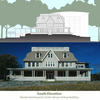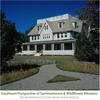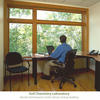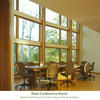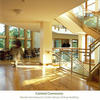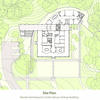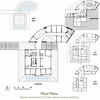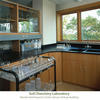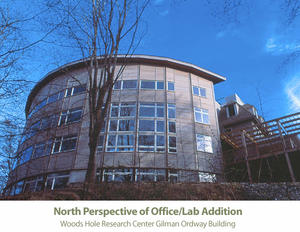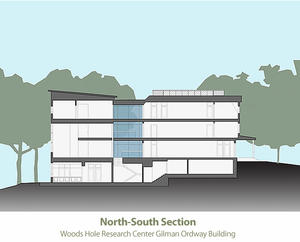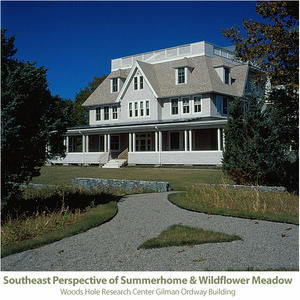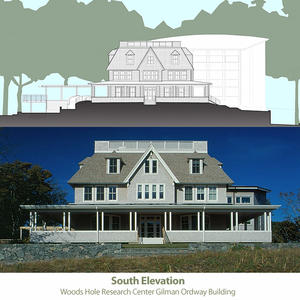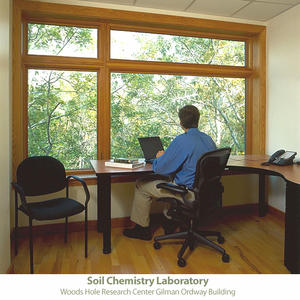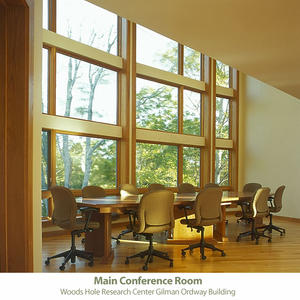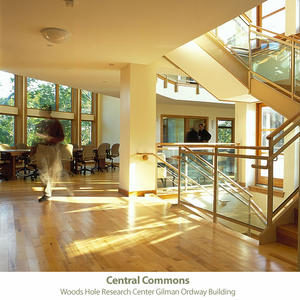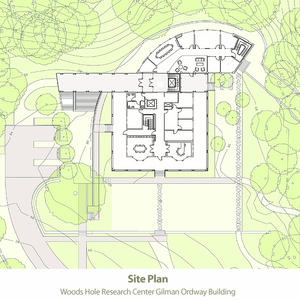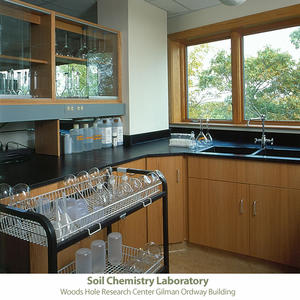Woods Hole Research Center
Project Overview
The Woods Hole Research Center is a scientific and policy institution dedicated to solving the complex issue of climate change and to defending the earth's great forests. In contemplating their consolidation in a new headquarters, trustees and staff agreed that this building should reflect the Center's core ideals, support their research and education mission, and promote the health of not only the building occupants, but the larger world as well.
Working within a challenging and constrained site, the design preserves the cultural landscape represented by an existing 19th-century summer home, respectfully and adaptively reusing the original house with the addition of contemporary office, laboratory, and common spaces.
Design & Innovation
Predesign
The Center and its design consultants were considered to be a single "design team" and collaborated closely. Adopting an integrated, whole-building design approach, the team addressed the diverse issues subsumed by the phrase "sustainability" and developed several key design principles.
Because of the Center's interest in reversing the progress of global warming, the team decided that the building would operate without burning fossil fuels like gas, oil, or coal on-site, instead using renewable sources of energy while aspiring to produce more energy than it consumed on a net annual basis.
To maintain the historic flavor of the site, the staff wished to preserve the essential character and appearance of the original Victorian summerhouse while upgrading its systems and amenities to create an energy-efficient office space.
The building's location in a sensitive coastal ecosystem made it imperative that local water quality be preserved, if not enhanced, which led to the installation of a denitrifying septic system and a rainwater collection system.
Finally, the Center's particular focus on healthy forests encouraged the use of certified and sustainably harvested wood for the facility's dimensional and finish lumber, both inside and out.
Design
The project’s ambitious performance goals led to the development of an ENERGY 10 simulation and the engagement of an energy-systems consultant through construction.
This project exemplifies the challenges of pursuing an extremely ambitious environmental agenda while raising funds throughout the process. Holds and delays, which occurred at every stage of architectural development, made it difficult to manage the project as a conventional design effort. In addition to site and code issues requiring changes in the building design during design development, the project’s extended duration required overcoming a lack of continuity in project staffing and production and made it tricky to limit the scope of services.
This start-and-stop component also illustrated the limited accuracy of cost estimating in a volatile construction market. The escalation of costs over the course of the project’s early fundraising phases far exceeded the expectations of any of the design team members. The team’s ultimate success in achieving its energy performance goals required active preservation of the mechanical system’s design intent through an extensive value-engineering phase that reduced approximately 15% from the construction budget.
Commissioning
The owner hired an independent commissioning agent.
Regional/Community Design
Land Use & Community
In 1998, the client acquired an eight-acre parcel of land just outside the village of Woods Hole, Massachusetts. The Woods Hole Research Center site includes approximately five acres of undisturbed forested upland and one of three 19th-century Victorian summerhomes perched prominently atop a ridge that parallels the main road leading to the village.
The decision to restore the existing house clearly dictated the site selection, but only one acre of the site is considered buildable. In addition to successfully addressing a steep, challenging, and constrained site, the master plan had to locate the contemporary addition in a way that respects and preserves the regional cultural landscape represented by the original house.
The site also lies within the watershed of Oyster Pond, a coastal pond at risk from nitrogen loading from septic systems, fertilizer, and atmospheric deposition. Both the client’s primary mission and its local environmental policy and research programs demanded that the project’s design, construction, and operation all respond effectively to the local landscape and watershed.
Community Connection
Working with the context of its rural setting, the project effectively addresses issues of community connection and supports available alternative mobility strategies. A desire to allow for future growth led the Center to a conscious decision to locate its new headquarters outside the town of Falmouth. The site enjoys close proximity to a “rails to trails” bike path, which serves the several staff members who prefer to cycle to work. The design provides preferential parking for carpoolers in the 20,000-ft2 lot. The design team also successfully persuaded the town zoning board to reduce the overflow parking required, proposing the alternative of using graded, mown portions of the wildflower meadow rather than increasing the amount of paving in the building’s front yard.
The project’s genesis as the preservation and expansion of the Victorian summerhome responds to the regional cultural landscape. While the decision to adapt and reuse the existing historic structure somewhat limits approaches to orientation and massing, the design of the contemporary office and laboratory addition and the surrounding landscape respond to the site-specific conditions and cycles.
The preliminary concept draws upon literal and metaphorical connections to the forest, with the existing building linked by the “stem” of the commons to the “leaf” of the new addition. Respectfully and modestly tucked behind the summerhouse, the addition is elongated along an east-west axis to optimize passive solar performance, and a common bleached cedar color palette visually integrates the two components.
The predominance of natural wood finishes both inside and out and the preservation of the original building’s traditional appearance gives the completed project a warmth and character familiar to its New England setting. Visitors within its comfortable, gracious spaces do not immediately recognize the structure as an advanced, “high-performance” building. This integration of new technology and New England sensibility is one of the building’s great successes and helps ensure its place not as an unattainable prototype, but as a practical, replicable, regional model.
Land Use & Site Ecology
The building lies within the watershed of Oyster Bay, a coastal pond at risk from nitrogen. Within this context, the presence of a pair of local research and policy programs studying the forests and waters of Cape Cod brings the global reach of the Center’s initiatives much closer to home. The Center develops techniques using satellite imagery to measure one widespread negative effect of development on coastal ecology. Excessive fertilization – largely created by conventional septic systems – results from wastewater discharge generated by population growth.
The Center’s policy and research programs and the building’s location within a sensitive coastal ecosystem made it imperative for the design of the project not to diminish local water quality but, rather, to enhance it where possible. A wastewater treatment system renders visible these research activities. As waste material moves through this innovative septic system, the Center’s soils science department collects data as they experiment with alternative denitrifying strategies. The building also supports best practices with water-conserving fixtures.
Permanent gravel parking areas manage stormwater on-site, as does a bioswale that directs runoff into a constructed wetland. A 1,200-gallon tank captures the rainwater required to achieve the goal of zero landscape irrigation, and a wildflower meadow replaces most of the lawn.
The project’s renewable energy strategy also responds to the local climate, with annual patterns of longer, sunnier summer days and shorter, cloudier, and windier winter days suggesting the adoption of a hybrid approach.
Bioclimatic Design
Thermal Comfort
-Provide occupants with the means to control temperature in their area
Visual Comfort and The Building Envelope
-Orient the floor plan on an east-west axis for best control of daylighting
-Use large exterior windows and high ceilings to increase daylighting
-Use skylights and/or clerestories for daylighting
Ventilation and Filtration Systems
-Provide occupants with access to operable windows
-Design ventilation system to exchange both heat and humidity between incoming and outgoing air
Light & Air
The design seeks to integrate inside and outside spaces by providing daylight, fresh air, and access to views throughout the building.
The open two-story “Commons” area at the junction of the two structures serves as the physical and visual locus for occupants of both sections. Large expanses of glass offer views into the forest canopy to the northwest and to the rhododendron garden to the southeast. This visual connection produces a prevailing sense of integration with the surrounding landscape.
Skylights direct light to interior spaces, and full-height windows in the new wing open to the surrounding forest. The use of double- and triple-glazed low-e glazing in these elements simultaneously serves building performance, aesthetics, and human comfort, providing maximum efficiency and enabling staff to rely on natural daylight.
Individual comfort and control of the indoor environment form another theme sustained throughout the project, with its operable office windows, fresh-air ventilation systems, and user-controlled temperature and lighting. A building monitoring system helps maintain comfortable temperature and humidity levels. Separate ventilation systems in laboratory spaces and low-VOC materials, paints, and adhesives further optimize indoor environmental quality. The open cell structure of the building’s Icynene insulation virtually eliminates subsequent offgassing of uncured materials.
Water Cycle
The building lies within the watershed of Oyster Bay, a coastal pond at risk from nitrogen. Within this context, the presence of a pair of local research and policy programs studying the forests and waters of Cape Cod brings the global reach of the Center’s initiatives much closer to home. The Center develops techniques using satellite imagery to measure one widespread negative effect of development on coastal ecology. Excessive fertilization – largely created by conventional septic systems – results from wastewater discharge generated by population growth.
The Center’s policy and research programs and the building’s location within a sensitive coastal ecosystem made it imperative for the design of the project not to diminish local water quality but, rather, to enhance it where possible. A wastewater treatment system renders visible these research activities. As waste material moves through this innovative septic system, the Center’s soils science department collects data as they experiment with alternative denitrifying strategies. The building also supports best practices with water-conserving fixtures.
Permanent gravel parking areas manage stormwater on-site, as does a bioswale that directs runoff into a constructed wetland. A 1,200-gallon tank captures the rainwater required to achieve the goal of zero landscape irrigation, and a wildflower meadow replaces most of the lawn.
The project’s renewable energy strategy also responds to the local climate, with annual patterns of longer, sunnier summer days and shorter, cloudier, and windier winter days suggesting the adoption of a hybrid approach.
Development Impacts
-Limit parking area
Runoff Reduction
-Avoid contiguous impermeable surfaces
-Install gravel paving in a matrix to retain permeability
Managing Stormwater
-Design a constructed wetland for pollutant removal from stormwater
Rainwater Collection
-Collect and store rainwater for landscape irrigation
Integration with Site Resources
-Integrate on-site wastewater treatment system with landscape design
Low-Impact Siting
-Select an already-developed portion of a site for new development
Energy Flows & Energy Future
The integration of passive-solar and energy-conservation strategies, optimal performance, and on-site renewable power generation make the building 83% more efficient than a minimally ASHRAE-compliant building.
A grid-connected, net-metered photovoltaic array; a closed-loop, ground-source heat-pump system; and a solar-thermal hot water system supply renewable electricity, heating and cooling, and water. Hydronic distribution provides silent radiant heating and cooling, and valance convectors offer individual zone control and much greater efficiency than conventional fan coil units. A planned on-site wind turbine will yield a net surplus of energy for the building.
Careful detailing of the building envelope stands foremost among the strategies used to achieve the project’s ambitious energy goals. Icynene spray foam insulates all exterior walls and roof assemblies, providing an extremely effective air barrier and optimized R-values. Other features that further enhance its performance include:
-Offset-stud framing in the exterior walls to eliminate thermal bridging;
-Double- and triple-glazed low-e glazing;
-Energy recovery ventilators using enthalpy wheels to recapture exhaust heat and moisture and to precondition incoming fresh air;
-An extensive energy-monitoring system that records electrical production and usage, as well as overall system performance;
-High-efficiency lighting controls and occupancy monitors;
-High-efficiency appliances and office machines.
Energy Security
Annual local climate patterns of longer, sunnier summer days and shorter, cloudier, and windier winter days suggested the adoption of a hybrid approach to the renewable energy sources on which this all-electric building relies.
Mounted atop both the new addition and the renovated summerhome’s porch sits a grid-connected, net-metered array of 88 photovoltaic panels. Rated at 26.4 kW, the array harvests more than 30,000 kWh of power each year – approximately one-third of the building's annual energy budget. On the hottest days of the past summer, the building was cooled by the ground-source heat-pump system powered by the solar panels alone. The system produced enough energy even during the middle of these days to return excess power to the grid.
A hydronic distribution system further enhances the groundwater system’s effectiveness. Valance convectors provide silent radiant heating and cooling with individual zone control and much greater electrical efficiency than conventional fan coil units. A solar-thermal hot water system supplies the building’s domestic needs. With the addition of a 100-kW wind turbine, currently awaiting permitting and approvals, the project’s on-site renewable sources are expected to generate more power than it needs to operate, making the building a net exporter of energy.
Metrics
Materials & Construction
A simple interior materials palette – most of which can be defined as either "silica" (glass, stone) or "cellulose" (wood) – supports the health of the building’s occupants and local and distant ecosystems while reinforcing the project’s design principles.
The tight building envelope employs spray-foam insulation not only because of its outstanding performance characteristics, but also because it contains no ozone-depleting blowing agents or formaldehyde that could compromise indoor environmental quality.
The Center’s forest research and policy initiatives emphasize the importance of using FSC-certified and sustainably harvested lumber throughout the building. Examples include sustainably harvested ash millwork; certified fir windows; certified maple flooring from Maine; certified cedar shingles, clapboard siding, and trim; and certified framing lumber and decking to the extent possible.
Stone walls rely largely on fieldstone and glacial erratics drawn from the site.
Careful selection of furnishings favors products with high recycled content in aluminum, fabrics, desk substrates, veneer, and steel components. Examples include task chairs and desk systems with high recycled content and conference tables from sustainably harvested or recycled sources.
Green Products Used
-HCFC-Free, Sprayed-On Polyurethane Insulation
-High-Performance Window Glazing
-Recycled-Content Porous Pavement
Green Strategies
Protection of Global Ecosystem
-Avoid rigid or blown foam insulation made with an HCFC blowing agent
Building Deconstruction
-Reuse existing structure
Pre-Consumer Recycled Materials
-Specify aluminum products made from high levels of recycled scrap
Materials and Wildlife Habitat
-Use wood products from independently certified, well-managed forests for rough carpentry
-Specify wood flooring from independently certified forestry operations
-Use wood products from independently certified, well-managed forests for finish carpentry
Transportation of Materials
-Prefer materials that are sourced and manufactured within the local area
Long Life, Loose Fit
The project’s adaptive reuse of the historic structure that figures as its public face represents its most noticeable long-term strategy, but other components of the design create enduring value for the client.
The current building program, and particularly the laboratory spaces, allows for the future growth of the organization and its research efforts. The durability of the primary building materials – the heavy framing that provides the thick envelope, the strong steel supports, and the high-quality sustainably harvested lumber used throughout the building – will likely enable the building to enjoy a considerably longer service life than conventional speculative office spaces.
Collective Wisdom & Feedback Loops
In order to make the project a replicable model, nearly all building systems use available "state-of-the-shelf" technology. An energy-monitoring system records electricity production and usage, thermal exchange at the ground-source heat pump and solar thermal system, and runtime and temperature differentials at the energy recovery units, and the soils science department actively experiments with the building's wastewater system to develop alternative denitrification strategies. The resulting data will educate both staff and the public about energy costs, energy savings, and the relative importance of systems and systems integration while moving toward buildings that produce more energy than they consume.
Other Information
As an established non-profit research institution, the Center clearly benefited from its established donor base, but two grants were crucial in securing a building that reflected their mission, values, and ambitions.
The Massachusetts Technology Collaborative's Green Buildings Program provided $226,308 for the purchase and installation of the building’s photovoltaic array and energy monitoring system. In addition to the vital role these play in the Center's educational efforts on renewable energy, the systems also provide the donor with additional research resources.
The Kresge Foundation awarded a $500,000 challenge grant to the Center during the critical final fundraising phase. The prestige of this gift did much to catalyze the Center’s efforts to raise the last funds required for the project’s completion.
The project architect also played a significant role throughout fundraising for the project. Notable among these efforts were the production of a fundraising brochure outlining the project’s design concepts and the presence of the firm’s founding principal at several of the client’s board meetings and public events.
Financing Mechanisms
-Grant: Private (foundation)
Cost Data
Cost data in U.S. dollars as of date of completion.
-Total project cost (land excluded): $6,200,000
The close connection between the client’s mission and the building’s energy goals meant that the design was predicated on achieving maximum performance through system integration rather than the exhaustive analysis of individual technologies through typical cost-payback scenarios. Among the components included in the finished design, the hydronic distribution system’s valance units are expected to have fast payback, though a formal analysis was not performed.
One of the most fundamental lessons learned was that restoring an old structure and upgrading its systems and amenities can, in fact, be less cost-effective than new construction. The institution’s decision did, however, preserve an important cultural and community legacy.
From a technical standpoint, the project’s energy-systems advisor offered lessons on the importance of minimizing air infiltration into the building envelope. The taping and sealing required to form a truly effective barrier is labor intensive, complex to document (especially in an old house), and nearly impossible to implement without constant expert site supervision. The use of low-density, open-cell, spray polyurethane insulation created a tight envelope by expanding to fill every gap and staying tight to the wood framing in the exterior walls and roof assemblies. The efficiency of all other systems benefited from this element.
Achieving the ambitious energy performance goals required fierce protection of the mechanical-system design through a value-engineering phase that cut approximately 15% from the construction budget.
Finally, within the project’s northern climate, the thermal comfort provided by triple-glazed windows strongly justifies their use beyond simple cost-payback calculations. Even on the coldest days, people sitting next to the large window walls are warm enough to work effectively.
Additional Images
Project Team and Contact Information
| Role on Team | First Name | Last Name | Company | Location |
|---|---|---|---|---|
| Architect (Associate partner / project manager) | Mark | Rylander | William McDonough + Partners | Charlottesville, VA |
| Architect | Jeff | Sties | William McDonough + Partners | Charlottesville, VA |
| Contractor | John | Million | TR White Company, Inc. | Boston, MA |
| Landscape architect | Warren | Byrd | Nelson-Byrd Landscape Architects | Charlottesville, VA |
| Energy consultant | Marc | Rosenbaum, P.E. | Energysmiths | Meriden, NH |
| MEP engineer | Robert | Somers, Ph.D, P.E. | 2rw Consulting Engineers, PC | Charlottesville, VA |
| Structural engineer | Nat | Oppenheimer | Robert Silman Associates | New York, NY |
| Lighting designer | David | Nelson | Clanton & Associates, Inc. | Boulder, CO |
| Civil engineer | Mike | McGrath | Holmes and McGrath, Inc. | Falmouth, MA |
| Renewable energy systems consultant | John | Kneffner | Northern Power Systems | Waitsfield, VT |
| Code consultant | John | Ferguson | Ferguson Engineering | Clarkson, MD |
| Cost estimator | Richard | Vermeulen | Vermeulens Construction Consulting | Unionville,ON Canada |
| Architect (Director of communications) | Kyle | Copas | William McDonough + Partners | Charlottesville, VA |
